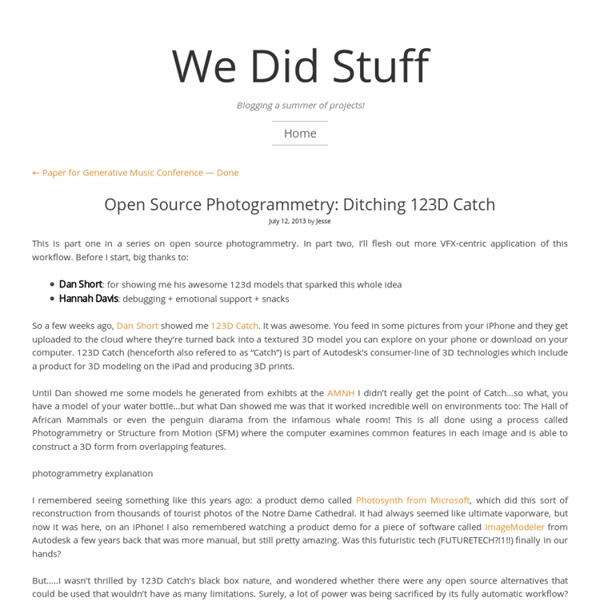



Photogrammetric Modeling + GIS Spring 2012 Edition Better methods for working with mesh data By Rachel Opitz, University of Arkansas, and Jessica Nowlin, Brown University The method of bringing photogrammetric data into a GIS to create simple visualizations described in this article is being used in ongoing University of Michigan excavations at Gabii, Italy. This article as a PDF. The authors describe how to bring photogrammetrically derived meshes into a GIS so that the 3D relationships between features can be easily understood, descriptive data can be integrated, and spatial analysis tools in GIS can support analysis and interpretation after the field project has ended. Photogrammetric Survey in Archaeology Close-range photogrammetric survey is increasingly popular as a recording method in archaeology. This technique is commonly used to document features with complex geometries or large numbers of inclusions, including walls, pavements, rubble collapse, and architectural elements. The Basic Process The Initial Mesh
Autodesk 123D Catch | 3d model from photos Download 123D Catch PC downloads, updates and requirements for 123D Catch. Download 123D Catch for PC View PC system requirements Microsoft® Windows® 7 (32-bit and 64-bit), Microsoft® Windows® XP Service Pack 3 or higher (32-bit and 64-bit) Intel® Core™2Duo 1 GB RAM 1 GB free disk space OpenGL compatible video card (OpenGL version 1.3 recommended) with 256MB or more memory Internet connection Microsoft run-time libraries* *Under most circumstances, the necessary dynamically loadable libraries (DLLs) will be present on your Windows system. After doing so, you can successfully rerun your 123D Catch install. 123D Catch update history Find the entire 123D Catch release history here. v2.2.3.557 / April 3, 2014 Fix to a false “Offline Mode” alert. Body Scanning | Ten24 We scan a full body in ultra high resolution 15k colour using our 80 X DSLR photogrammetry system. If you are looking for a portable fast body scanning solution we can use our ultra compact Artec M scanning system. Using the Artec we can scan a full body in about 2 minutes and provide you with a model within the hour.
Mobile mapping and surveying of land, coastal and waterway areas Working with Dynascan has helped surveyors in a range of industries survey large and difficult-to-access areas, while working cost effectively. Our systems are lower in price than those offered by other companies, yet backed by remote diagnostic support and functionality-rich software. The small size and weight of Dynascan models make them versatile enough to deploy on a range of vehicles or vessels. You can now dynamically survey areas of limited or difficult access, including steep narrow tracks, parks, small river tributaries, and narrow waterways. Dynascan contains no delicate scanning mechanisms or rotating mirrors, and is designed to operate in the world's most extreme environments. Dynascan is built to industrial specifications and with an all-weather design that ensures the system will operate after long trans-shipment journeys, minimising downtime on the job and time spent in the repair shop.